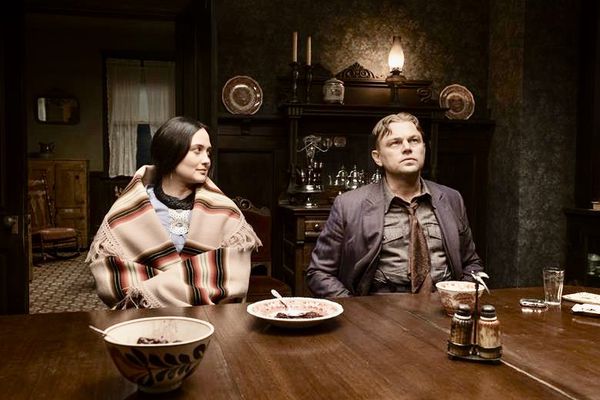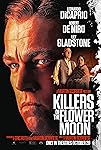Eye For Film >> Movies >> Killers Of The Flower Moon (2023) Film Review
Killers Of The Flower Moon
Reviewed by: Andrew Robertson

It begins with a symbolic funeral. Symbolic there, as well as to the audience, a recognition of the change of an era, a burial of the old ways. From the ground comes something new. Oil, erupting. Perhaps that is the start, circular with the ending, a dance. One shot from above, showing the spiral around the drum. One shot in slow motion, showing what will be wealth against the skin. One shot of many, including archive footage whose incongruities include silent newsreel produced by the then Fox News.
A Martin Scorsese film, and even if you did not know you would be reminded by theme and habit and cast and construction and, latterly, the man himself. At a point near the end of the story he appears as one of those telling the story, a recursion that was one of many things that reminded me of the similarly awe-inspiring Beau Is Afraid. This includes a fair amount of magic in the realism, not a blurring of the boundaries because everything is crisp, no matter how painted.
There are thematic parallels with so many Scorsese works, so many actors recurring, that to list them all one would be as well to point to his filmography as a whole. His fascinations with crime, with period detail, with the lies individuals, organisations, societies tell themselves. His fondness for history, for conflict, his mastery of his craft, the performances elicited from his cast.
Leonardo di Caprio is Ernest Burkhart, returned wounded from the war to the welcoming embrace and tight clutches of his uncle. Robert De Niro is the cattleman and 'friend of the Osage' William Hale, fluent, forceful, given to prayer though less mindful of his flock than husbanding his stock. He brings Ernest together with Mollie, one of the Osage, part of a large family who control the headrights. That's where wells are sited, the extractive part of the process. The wealth might be underground, buried, like motivations, but the mechanisms of acquisition loom across the land. So frequent across the horizon they are as letters printed in a headline, each 'A' a frame like scaffolds, waiting for the good noose.
Lily Gladstone is hardly a newcomer but surrounded by veterans like De Niro and di Caprio she more than acquits herself. She commands each room she is within, even when these are rooms in which she is lost. Within her family Tantoo Cardinal, Cara Jade Myers, Janae Collins, Jillian Dion, and I do not seek to minimise any of their roles but everything comes back to the three, di Caprio, De Niro, and on that same podium Gladstone.
There are dozens of others, performances wrought from the wringing of hands or old-looking faces in old-looking places. When Jesse Plemons (14 years his junior) calls di Caprio "son" it's not about age but station. When Ernest gets himself a white hat there's a moment where one hopes that the traditions of the Western will hold true but they emerge grubbier, grander, greater. There's good, bad, ugly, more. It's not only dollars by the fistful but institutions, insulin, insurance, all the trappings of power and all those trapped within them.
William Hale says "call me King" and people do. Shakespeare had Lear lamenting inheritance from another direction, but Hale is one of several figures where history and tragedy are two sides of the same 30 pieces of silver. When he says "settle down" it might be the patrician or the stockman, when he moves they are as pieces on the chessboard. Black, and white, and red, and green. Envy and the dollar play their part as much as Calvin Coolidge and the Boxer Rebellion.
Brendan Fraser and John Lithgow appear as lawyers, but in the courtroom scenes they share it's even more important to look for familiar faces in the jury. When Fraser's WS Hamilton has the chance to confer with his client, the notions of privilege don't include confidentiality. These are men of law, suits, possessed of authority and no less authoritarian for it.
Jacqueline West's costume work is amazing. I'm not alone in lamenting how often costume prizes go to period dramas because the work is differently visible, but the quality here isn't just in the fabric but the cutting. There's a wedding suit, richly pleated at the back that speaks to a very particular conspicuousness of consumption. While there are traps for the unwitting everywhere, the most obvious snares are in the score.
The late Robbie Robertson provides an evolving score whose roots in early blues and rhythm are audible in their instruments. In the quickly unfolding credits, two-column, I did not catch if there was slide-guitar among them, but nothing felt out of place. Indeed it felt very much of place, of time, the list of tracks including at least half a dozen songs with 'blues' in their title. The devil does not need to wait at the crossroads, he can invite you into his home.
Scorsese shares credits as co-writer with author and journalist David Grann, upon whose book it is based. In a book within the film the title is given explanation, one of many places where other works are reflected, give room for reflection. Eric Roth also co-writes, and he has form for adaptations, at least ten based on books (from Munich to Dune, Forrest Gump to The Postman) and a few with thematic parallels. The Good Shepherd, directed by one of this film's stars, fictionalised some of the early actions of the Central Intelligence Agency. The Osage murders were some of the first actions of what was then the Bureau of Investigation, now known better as the FBI.
"Murders" not used incautiously, this was, is, ruthless. The rooms that white men have built and use on Osage land are just some of the ways that they seek to control. Billiard hall and barbers, Masonic Lodge and Main Street, all are laid out with the perfection of parasitism. That ruthlessness extends to Ernest, a moment he has to acquit himself is, well, let us not call it spoilers. Let us say that everyone watching knows. That dramatic irony far from the only thing borrowed from even older stories, Scorsese has built a stage that's already got a railway. Latterly, as said, appearing on one himself, a recursive dramatisation of the consequences of that lucky strike.
Questions of sponsorship are literally highlighted, against the curtain hanging high. Were Apple not bankrolling this, were Scorsese not Scorsese, then would the 206 minutes be possible? It is still not the whole story, just the bits we can see, even if those include the ancestors, the owls, the past. Di Caprio's performance, often beaten down and mumbling, reminded me often of Joaquin Phoenix but I wonder how much of that came not from Beau but The Master. In Once Upon A Time ... In Hollywood it was as a faded star that Tarantino cast him, but here for Scorsese he is supplicant, given a chance to do troubled bidding.
I remember when I saw The Irishman that someone near to me kept checking their phone's clock, increasingly agitated by the pace of a film that took three minutes longer to cover a similar span of years. As here, I don't think more than a moment or two are indulgent, wasted. Even when we are only watching dancing we are learning something, but I don't know how often it could have stepped more lively. There are so many threads in its weave that even the sharpest cuts cannot bring ends to all of them. Everything, at least as I recall it, builds to a totality, an epic, a saga. It carries on long enough that it can tell its story within itself, a serpent of mythology, devouring its own tale. It's still too much. That richness becomes something sickly, not the saccharine melodrama of Spielberg nor the overproduction of Cameron but nonetheless difficult to digest, at least in one sitting. That length of course brings back older debates about media, Scorsese makes films, but in framing something this large he has built something difficult to approach.
It is Scorsese at his, one hesitates to say peak, but absolute. The montages, the flashbacks, the themes, the tones, the score, the use of extant music, the this, the that, the other thing. Even appearing before the curtain, the elements of the business they call show and how it consumes the truth, history, endings. Over the credits more of Robbie Robertson's music, traditional chant, but most importantly the sound of rain. When the storm comes keep quiet and listen. Even after all those hours it is helpful to have space to think back, to recall, to reflect.
Among the film's many closed loops a pair of ear-rings, ones that are seen in several places, frame several faces. Do they match because having seen them someone wanted some the same? As a gift? As a good? Do they match because the sets were sold as sets, bought as boast? It's a small enough detail that I saw them because I was looking for them. Even when faces fill frames, storeys tall in the cinema, it is the little things that count. Killers Of The Flower Moon is no little thing. It is a testament, testimony and testimonial.
Reviewed on: 14 Oct 2023


















